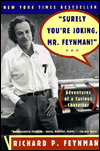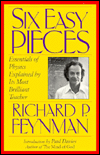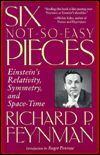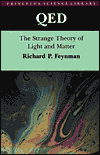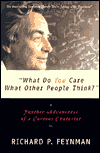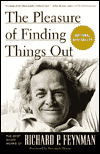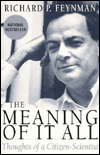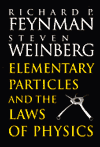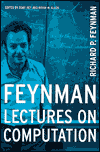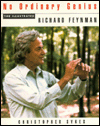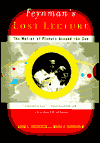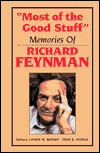Home > Directory > Nanotechnology Books > Richard Phillips Feynman Books
Richard Phillips Feynman Books
Richard P. Feynman (1918-1988) was widely recognized as the most creative physicist of the post-World War II period. His career was extraordinarily expansive. From his contributions to the development of the atomic bomb at Los Alamos during World War II to his work in quantum electrodynamics, for which he was awarded the Nobel Prize in 1965, Feynman was celebrated for his brilliant and irreverent approach to physics. It was Feynman's outrageous and scintillating method of teaching that earned him legendary status among students and professors of physics. Feynman helped to shape the world as we know it, and was a man of many dimensions -- Nobel laureate, iconoclastic icon, caring family man, amateur artist, and professional musician (in a Rio de Janeiro samba band). If Richard Feynman had not existed it would not be possible to create him. The most extraordinary scientist of his time, a unique combination of dazzling intellect and touching simplicity, Feynman had a passion for physics that was merely the Nobel Prize-winning part of an immense love of life and everything it could offer. He was hugely irreverent and always completely honest - with himself, with his colleagues, and with nature.The New York Times called him "the most brilliant, iconoclastic, and influential of the postwar generation of theoretical physicists." He remains one of the most admired scientists of our time.
Here is a collection of an even dozen of the most popular books by and about Richard Phillips Feynman. Some written by him, and some by his friends and colleagues. If you want to see the complete series, simply cut and paste his name into the search box above, select "Author", and click on the "SEARCH" button. This will take you into Barnes & Noble, and show all the books written by Feynman, et al. Once there, you will also see all the audio books as well. If you have other favorites that are not shown here, please us and it will be added.
NEWPerfectly Reasonable Deviations From The Beaten TrackThe Letters of Richard P. Feynman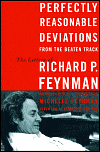
|
Insightful and delightful. Those who appreciate Feynman the scientist will love Feynman the man. Get a rare glimpse into the life of one of the great minds of the 20th Century. A must-read for Feynman fans.
Buy Perfectly Reasonable Deviations From The Beaten Track "The most original mind of his generation." -Freeman Dyson "For him knowledge did not describe; it acted and accomplished. . . . The science he helped create was like nothing that had come before." -James Gleick "The more one reads of Feynman, the more one falls in love with his refreshingly enthusiastic view of the world." -Alan Guth |
|
|
Here are the outrageous exploits of the world's most outspoken Nobel Prize-winning scientist. From the Publisher: "Richard Feynman was a great scientist, a winner of the Nobel Prize, remembered equally for his laboratory work on liquid helium and his wonderful, unquenchable vitality and sense of humor. His lighthearted approach to life made his lectures a delight and his scientific accomplishments all the more intriguing. Feynman was interested in everything. He painted, traded ideas with Einstein and Bohr, calculated odds with Nick the Greek, accompanied ballet on the bongos. Here is Feynman's astonishing life story -- a combustible mixture of high intelligence, unlimited curiosity, eternal skepticism, and raging chutzpah. "Anyone who can read it without laughing out loud is crazy." (Los Angeles Times Book Review) |
|
|
Synopsis -- This book reprints six chapters from Feynman's Lectures on Physics, which the scientist delivered from 1961 to 1963 at the California Institute of Technology. . . . {The chapters} discuss atoms, basic physics, the relation of physics to other sciences, the conservation of energy, gravitation, and quantum behavior." (Libr J) Index. From the Publisher: From 1961 to 1963, Feynman, at the California Institute of Technology, delivered a series of lectures that revolutionized the teaching of physics around the world. Six Easy Pieces, taken from these famous Lectures on Physics, represents the most accessible material from this series. In these six chapters, Feynman introduces the general reader to the following topics: atoms, basic physics, the relationship of physics to other topics, energy, gravitation, and quantum force. With his dazzling and inimitable wit, Feynman presents each discussion without equations or technical jargon. Readers will remember how - using ice water and rubber - Feynman demonstrated with stunning simplicity to a nationally televised audience the physics of the 1986 Challenger disaster. It is precisely this ability - the clear and direct illustration of complex theories - that made Richard Feynman one of the most distinguished educators in the world. Filled with wonderful examples and clever illustrations, Six Easy Pieces is the ideal introduction to the fundamentals of physics by one of the most admired and accessible scientists of our time. |
|
|
From the Publisher: No single breakthrough in twentieth-century physics (with the possible exception of quantum mechanics) changed our view of the world more than that of Einstein's discovery of relativity. The notions that the flow of time is not a constant, that the mass of an object depends on its velocity, and that the speed of light is a constant no matter what the motion of the observer, at first seemed shocking to scientists and laymen alike. But, as Feynman shows so clearly and so entertainingly in the lectures chosen for this volume, these crazy notions are no mere dry principles of physics, but are things of beauty and elegance. No one - not even Einstein himself - explained these difficult, anti-intuitive concepts more clearly, or with more verve and gusto, than Richard Feynman. |
|
|
From the Publisher: "Physics Nobelist Feynman simply cannot help being original. In this quirky, fascinating book, he explains to laymen the quantum theory of light a theory to which he made decisive contributions."--The New Yorker "Feynman's lectures must have been marvellous and they have been turned into an equally entrancing book, a vivid introduction to QED which is leavened and enlivened by his wit. Anyone with a curiosity about physics today should buy it, not only to get to grips with the deepest meaning of quantum theory but to possess a slice of history."--Pedro Waloschek, Nature |
|
|
Synopsis -- The first part of this book by the American physicist contains reminiscences about his father and his childhood beginnings as a scientist, his wife Arlene and her death of tuberculosis, and anecdotes, letters, photos and drawings. The second half of the volume concerns Mr. Feynman's role in the investigation of the Challenger space shuttle disaster. From the Publisher: When Richard Feynman, who won the Nobel Prize in Physics, died in February 1988 after a courageous battle with cancer, the New York Times called him "the most brilliant, iconoclastic, and influential of the postwar generation of theoretical physicists." Here, in these "further adventures," a companion volume to "Surely You're Joking, Mr. Feynman!," is another healthy dose of Feynman's irreverent zest for life and an even deeper, wiser level of reminiscence. He tells us of his father, who taught him to think, and of his first wife, Arlene, who taught him to love, even as she lay dying. And Feynman takes us behind the scenes of the presidential commission investigating the space shuttle Challenger's explosion and to the dramatic moment when the cause of the disaster was revealed simply and elegantly as Feynman dropped a rubber ring into a glass of ice water and pulled it out, misshapen. |
|
|
From the Publisher: Richard Feynman was one of the greatest physicists of the 20th century - from his work on the atomic bomb to his solution to the puzzle of the Challenger disaster. Feynman helped to shape the world as we know it. Nobel laureate, iconoclastic icon, caring family man, amateur artist, and professional musician (in a Rio de Janeiro samba band), Feynman was a man of many dimensions.. "The Pleasure of Finding Things Out" is a treasury of the best of Feynman's short works - from interviews and speeches to lectures and printed articles. |
|
|
From the Publisher: In April 1963, Richard P. Feynman gave a series of remarkable lectures at the University of Washington in Seattle. These three consecutive talks were classic Feynman - full of wit and wisdom - but their subject matter was wholly unexpected: Feynman spoke not as a physicist but as a concerned fellow citizen, revealing his uncommon insights into the religious, political, and social issues of the day. Now, at last, these lectures have been published under the collective title The Meaning of It All. Here is Feynman on mind reading and the laws of probability and statistics; on Christian Science and the dubious effect of prayer on healing; and on human interpersonal relationships. Here is the citizen-scientist on the dramatic effect simple engineering projects could have on the plague of poverty; the vital role creativity plays in science; the conflict between science and religion; the efficacy of doubt and uncertainty in arriving at scientific truths; and why honest politicians can never be successful. |
|
|
From the Publisher: Elementary Particles and the Laws of Physics contains transcriptions of the two lectures given in Cambridge, England, in 1986 by Nobel Laureates Richard P. Feynman and Steven Weinberg to commemorate the famous British physicist Paul Dirac. The talks, given for nonspecialists and undergraduates in physics, focus on the fundamental problems of physics and the present state of our knowledge. Professor Feynman discusses how the laws of physics require the existence of antiparticles; Professor Weinberg examines the development of the fundamental laws of elementary particle interaction. |
|
|
From the Publisher: From 1983 to 1986, the legendary physicist and teacher Richard Feynman gave a course at Caltech called "Potentialities and Limitations of Computing Machines." Although the lectures are over ten years old, most of the material is timeless and presents a "Feynmanesque" overview of many standard and some not-so-standard topics in computer science. These include compatibility, Turing machines (or as Feynman said, "Mr. Turing's machines"), information theory, Shannon's Theorem, reversible computation, the thermodynamics of computation, the quantum limits to computation, and the physics of VLSI devices. Taken together, these lectures represent a unique exploration of the fundamental limitations of digital computers. Feynman's philosophy of learning and discovery comes through strongly in these lectures. He constantly points out the benefits of playing around with concepts and working out solutions to problems on your own - before looking at the back of the book for the answers. As Feynman says in the lectures: "If you keep proving stuff that others have done, getting confidence, increasing the complexities of your solutions - for the fun of it - then one day you'll turn around and discover that nobody actually did that one! And that's the way to become a computer scientist." |
|
|
From the Publisher: If Richard Feynman had not existed it would not be possible to create him. The most extraordinary scientist of his time, a unique combination of dazzling intellect and touching simplicity, Feynman had a passion for physics that was merely the Nobel Prize-winning part of an immense love of life and everything it could offer. He was hugely irreverent and always completely honest - with himself, with his colleagues, and with nature. "People say to me, 'Are you looking for the ultimate laws of physics?' No, I'm not. I'm just looking to find out more about the world, and if it turns out there is a simple ultimate law that explains everything, so be it. That would be very nice to discover. If it turns out it's like an onion with millions of layers, and we're sick and tired of looking at layers, then that's the way it is....My interest in science is to simply find out more about the world, and the more I find out the better it is. I like to find out." This intimate, moving, and funny book traces Feynman's remarkable adventures inside and outside science, in words and in more than one hundred photographs, many of them supplied by his family and close friends. The words are often his own and those of family, friends, and colleagues such as his sister, Joan Feynman; his children, Carl and Michelle; Freeman Dyson, Hans Bethe, Daniel Hillis, Marvin Minsky, and John Archibald Wheeler. It gives vivid insight into the mind of a great creative scientist at work and at play, and it challenges the popular myth of the scientist as a cold reductionist dedicated to stripping romance and mystery from the natural world. Feynman's enthusiasm is wonderfully infectious. It shines forth in these photographs and in his tales - how he learned science from his father and the Encyclopedia Britannica, working at Los Alamos on the first atomic bomb, reflecting on the marvels of electromagnetism, unraveling the mysteries of liquid helium, probing the causes of the Challenger space shuttle disaster. |
|
|
From the Publisher: Rescued from obscurity, Feynman's Lost Lecture is a blessing for all Feynman followers. Most know Richard Feynman for the hilarious anecdotes and exploits in his best-selling books "Surely You're Joking, Mr. Feynman!" and "What Do You Care What Other People Think?" But not always obvious in those stories was his brilliance as a pure scientist--one of the century's greatest physicists. With this book and CD, we hear the voice of the great Feynman in all his ingenuity, insight, and acumen for argument. This breathtaking lecture--"The Motion of the Planets Around the Sun"--uses nothing more advanced than high-school geometry to explain why the planets orbit the sun elliptically rather than in perfect circles, and conclusively demonstrates the astonishing fact that has mystified and intrigued thinkers since Newton: Nature obeys mathematics. David and Judith Goodstein give us a beautifully written short memoir of life with Feynman, provide meticulous commentary on the lecture itself, and relate the exciting story of their effort to chase down one of Feynman's most original and scintillating lectures. David and Judith Goodstein live in Pasadena, California. |
|
|
From Booknews
Gell-Mann writes critically of Feynman's aberrations and of his energy, playfulness and vitality, and of his directness. He celebrates the man's creativity. Other contributors (Wheeler, Bethe, Dyson, Schwinger, Bjorken, Goodstein, Cohen, Goldberger, Hillis, Joan Feynman, and the editors) are less critical. The papers are strong on science with a nice leaven of personal comments. A too brief collection of Joan Feynman's photos is included. Few collections dare pass this splendid exposition of a great and humane mind. Annotation c. Book News, Inc., Portland, OR (booknews.com) |
|
|
||
|
|
||
| The latest news from around the world, FREE | ||
|
|
||
|
|
||
| Premium Products | ||
|
|
||
|
Only the news you want to read!
Learn More |
||
|
|
||
|
Full-service, expert consulting
Learn More |
||
|
|
||
